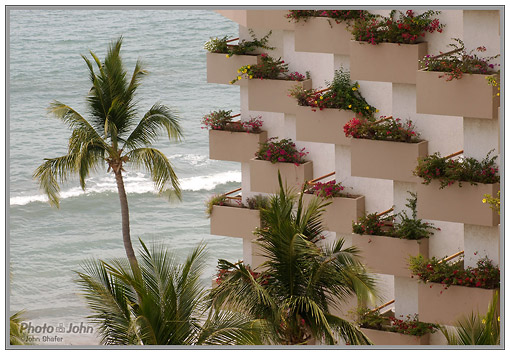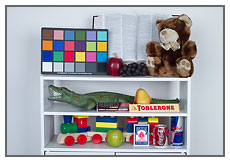Olympus E-PL1 Image Quality
The Olympus E-PL1 uses the same 12-megapixel Four Thirds sensor as the E-P1, E-P2 and all the Panasonic G Micro Four Thirds cameras. The Four Thirds sensor is smaller than the APS-C sensors in consumer digital SLRs but it’s still much larger than even the best compact camera sensors (think Canon PowerShot G11 and Panasonic Lumix LX3). And when it comes to image quality and pixels – bigger is better. As expected, the E-PL1′s image quality is noticeably better than even the best compact cameras and not quite as good as most entry-level and mid-range digital SLRs. The question is – is it good enough to justify leaving the DSLR at home or investing in an E-PL1 instead of a digital SLR?
The 12-megapixel Four Thirds sensor compares well to entry-level digital SLRs at low ISO settings. At ISO 400 and higher the E-PL1 and other Micro Four Thirds cameras start to show more noise than APS-C DSLRs. But that doesn’t mean the Micro Four Thirds image quality is bad. At ISO 400 and 800 the E-PL1 looks very good. I’ve shot up to ISO 3200 and it gets pretty dirty up there. I’d say ISO 1600 is acceptable when push comes to shove but it’s best to keep it at ISO 800 and below if possible. Unless you’re trying to freeze action or using long telephoto lenses, there’s little need to go over ISO 400 or maybe 800 – especially when you consider the E-PL1′s built-in, sensor-level image stabilization
 |
 |
 |
 |
 |
 |
Click on thumbnails to view sample photos.
A final note about the E-PL1′s image quality – I shoot RAW whenever possible. But I’ve only shot JPEGs with the E-PL1. I’m not recommending shooting JPEGs – RAW files always offer more flexibility and better image quality potential. My only reason for shooting JPEG is pure laziness – when I got the camera Adobe Lightroom didn’t support the RAW files so I just shot JPEGs. And I’m still shooting JPEGS. My point is – the E-PL1′s image quality is good enough that I didn’t even bother shooting RAW. Bonus – JPEG means more images on your memory card – excellent when you’re traveling.
|
Next – Olympus E-PL1 Conclusion >>
|





Whilst I completely agree with the comment that AF performance isn’t up to DSLR quality and I wish they put in an AF illuminator into this camera., I think you’re way off base with the image quality not up to most DSLRs. Which DSLRs are you comparing this camera to? I own a Canon 450D and the pics from my new E-PL1 are actually quite visibly better!
I have had a look at DPReview.com and their image quality analysis results are very different from yours. Also the lack of EXIF data in your studio samples are not helpful. It’s hard for me to tell whether your settings are right. Also if I may say, Adobe’s raw converter just doesn’t bring out the best in this camera – and furthermore you haven’t quite stated the Lightroom settings used, etc. You should try Olympus’ free Viewer 2.0 raw converter using the Olympus RAW algorithm.
Thanks for your comment, Jonathan. just downloaded one of the studio tests and I can see the EXIF data. I’m not sure why you weren’t able to see it. What settings do you want to know about? I’ll be happy to provide whatever information you want. As for which cameras I’m comparing it to. There wasn’t a particular set of cameras. Your 450D is two generations old, though. If you want, you can download our 450D studio samples and compare those. I’m comparing to more current cameras like the Nikon D5000, D90, Canon EOS 7D, 550D, etc. High ISO image quality is definitely better with those cameras. To be clear though – I never said the E-PL1 was bad. It’s just that you’ll get better from a D5000, D90, 550D, etc. How many people actually need better, though?
Regarding Lightroom – I said I made no adjustments. That means all I did was open the file and convert it to a TIFF. I made no adjustments while it was open in Lightroom. For what it’s worth, I’ve used the Olympus software and I don’t like it. It’s clunky and slow. And I’ve done some careful comparisons between Lightroom and the Olympus software and haven’t seen any noticeable image quality difference with conversions from the same images. If there is a difference, it’s news to me.
No matter what, I appreciate your comments. You’re free to disagree with me on anything you want. In fact, a little disagreement is good because it makes people think for themselves and look a little closer. Since you own an E-PL1 I would be very pleased if you’d write a review in our user reviews. That’s really the best way for you to share your experience with the camera.
The autofocus is slower than a dslr but I think you need to better qualify what that means. For a great many people including dslr users the need for that extremely fast autofocus is not necessary. I shoot with Nikon D700 cameras, D5000, as well as many others and for my type of photography AF speed is not critical. I find the Olympus Micro Four Thirds more than adequate to get the job done. Everything is relative.
Image quality? You are way off base. I have worked in the photography industry for a great many years. Over 40 and as far aas I am concerned the image quality rivals a great many current dslr’s that are out there today.
As for lenses, what are you missing? Between Olyjmpus and Panasonic there is just about every range covrered and if that is not enough then get adapters for Niikon, Canon, Leica, Pentax, Contax, etc. I rally enjoy using my Voigtlander Noktons on this camera. The Olympus 9-18 will knock your socks off. So will my 50mm 1.1 Nokton.
Lightroom 3 does a great job on jpegs, tiffs and raw. And yes, the Olympus software is horrible.
I think the image quality on e-pl1 is realy bad compared most dslr, especially indoors. Even iso 100 have visible grain! Iso 500 is HORRIBLE! Sure outddors and for travel its o.k, but it can not replace a real dslr, never….
People who claime that fast af is not necessary…. well lets just say they don´t have kids running around…. For static pictures its o.k of course, but if your subject starts moving…. no its not good at all.
Every photomagazine criticizes the af…. so its not just this review……
” the image quality rivals a great many current dslr’s that are out there today.”
Thats simply not true…. Not even close. As I said; even at iso 100 you have real visible grain…. Maybe your angry because someone points out the obvious?
But its ligth and easy to take with you when traveling, sure, but shouldn’t you have the best camera for those pictures?
I sold my 40d for the e-p1 and never looked back. The indoor shots I have taken with the 20mm 1.7 panasonic hardly need any flash and are NOT grainy? The 40d was a lower noise camera for sure but not that much for the huge size to carry every where hour after hour.
The 45-200mm is a killer lens and the 14-42 is supreme for any stock kit lens have owned from nikkor to canon. Would put it up to any of the canon kit lenses I had that were just plain cheap compared to it.
No perfect camera exsist so compromise is everything and the olympus micro 4/3 delivers in spades with low noise and feature the others simply do not have.
“No perfect camera exsist so compromise is everything and the olympus micro 4/3 delivers in spades with low noise and feature the others simply do not have.”
I totally agree with that statement, John. Thanks for sharing your experience with us. Please also write a review for your camera for us. The user reviews are really the best place to share your experience with the camera. Here’s a link to the Olympus E-PL1 user review page: http://www.photographyreview.com/cat/pcphotoreview/digital-cameras/digital-slrs/olympus/PRD_449659_3127crx.aspx
I owned a nikon d5000 with nikon kitllens and 18-200VR.
Sold the lot and bought E-pl1 + panasonic 14-140.
Outperformes the nikon combination.
\blurring\ or \softening\pictures to hide noise ( and detail)? Buy the nIkon.
JC
Nice. When I’m ready to replace my G10, this will be one to look at closely. The ISO performance is pretty solid for a compact- huge to me since I like to have a compact (unless I’m sporting the 7D) along at all times when I’m mountain biking.
Very useful comments and review. Just one question – what are these Panasonic lenses people are talking about? Are they made for the Pen? I am thinking seriously of buying an E-PL1 twin lens kit to add to my 450D + 24-105 f4 L USM, but need as much relative info as possible. There seems some dissension on the actual standard of the images produced. Thanks again.
Ian – Glad you like the review. Thanks for your comment. You should check out our EVIL & Micro Four Thirds Cameras Forum. You’lll find lots of information there. But to answer your question – the Micro Four Thirds format cameras from Olympus and Panasonic share a common lens mount. So a Panasonic Micro Four Thirds lens will fit an Olympus Pen camera, and vice versa. There are also a lot of adapters available so you can mount Canon, Nikon, Leica and other lenses.
I’ve come to this review very late (October 2011!) while I was looking for info on lenses, having just bought the E-PL1 (late again but at a massive price discount). From the perspective of a complete newbie photographer for whom the E-PL1 is his frst \real\camera I have found both the review and the comments very informative and have, happily, confirmed that I made the right choice. Many thanks to all who contributed.
If anyone does read this in the near future, I am considering buying the 40-150mm lens since I figure that with the 14-42 kit lens I will have a good wide angle and zoom options for considerably less than buying the 14-150 lens (£249 for the E-PL1 and kit lens + £149 for the 40-150 lens vs £599 for the 14-150 lens alone). Is there any fault in my logic, any reason why it would be a much better idea to have only the one lens (14-150mm), in spite of the cost?
Many thanks in advance.
isn’t it nice? I’m planning to ask mom to buy this for me to replace my old cam